Art & Science Collaborations: A Brief History
The Caltech/Art Center NEURO project seeks common ground between art and science, and is motivated by the belief that a spark of unexpected creativity can result when each discipline is encouraged to ignite the other. Accelerated by an unprecedented pace of scientific and technological advancement over the past one-hundred fifty years, current expolorations at the intersection of art, science, and technology are in fact the benficiaries of a much longer history.
The first, perhaps, integration of art and science appears in Paleolithic cave paintings, in which evidence of human artistic ability is combined with what might also be called the first illustrations of scientific observation. Later on, to the Greeks, art was defined as techne. According to Aristotle, techne was "a capacity to do or make something with a correct understanding of the principle involved," and as a branch of knowledge was considered to be a form of practical science. And, of course, Leonardo da Vinci has historically been considered a consummate integrator of art and science.
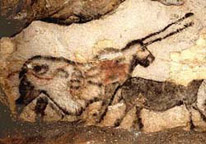
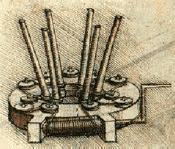
Closer to our own century, German composer Richard Wagner created the concept of a Gesamtkunstweerk, or "total artwork," in an 1849 essay called "The Artwork of the Future." His idea was to achieve a comprehensive integration of the various arts, unifying music, dance, stage, and visual arts into a robust and multi-layered experience.
In the early 20th century, the Futurists and Constructivists followed a similar trajectory, courting a close alignment between integrated art disciplines and industrial technology that became institutionalized by a utopian vision permeating the German school of art and design, the Bauhaus. As two world wars intervened, a migration of avant-garde thinkers descended upon the eastern United States to escape the turmoil in Europe. Technology, advanced by the necessities of the two wars' life and death political and ideological struggles, made of the late 1940s and 50s a vast technological delta containing the first computers and many other promising inventions to be tinkered with by artists.
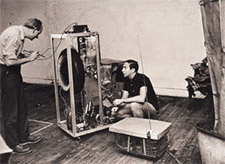
Kluver/Rauschenberg
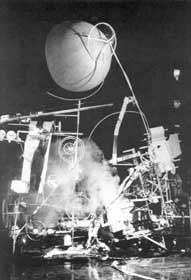
Tinguely, 1960
Joint projects were developed over a decade between KlŸver and artists such as Andy Warhol, Rauschenberg, Tinguely, John Cage and Jasper Johns, and were shown at venues ranging from MoMA to the Pepsi-Cola pavilion at the World Expo '70 in Osaka, Japan. Locally, the Los Angeles County Museum of Art initiated an art and technology program in the late 1960s through the early 70s, and in 1969 Ð 71 Caltech had its own version of E.A.T.
Pollock, 1950

In the 1970s, programs such as the Xerox Palo Alto Research Center's Artist In Residence Program (Xerox PARC PAIR Program) echoed the E.A.T. model, bringing artists and scientists together in collaborative enterprises. Other cross-disciplinary institutions have emerged over the last decade-and-a-half which integrate art, design, science, technology, and media studies, including the Banff New Media Institute; MIT Media Lab; Center for Advanced Visual Studies (CAVS) at MIT; ART + COM; Interval Research; Eyebeam, in New York; UIAH (Media Lab, University of Art and Design, Helsinki, Finland); Hexagram (Concordia University and University of Quebec at Montreal); Center for Art and Media (ZKM), Germany; InterCommunication Center [ICC], Japan; and Institute of Advanced Media Arts and Sciences, Japan, to name a few.
Combined with access to significant data-processing power brought about by the advent of affordable desktop computing and software expressly written for image manipulation, the institutions supporting art and technology projects have enabled a new generation of artists to begin realizing artistic vectors imagined forty years ago -- when the implications of advanced communications technology were first glimpsed by visionary artists and engineers. Out of computer trade shows such as SIGGRAPH and Ars Electronica in the early 1990s, before museums and educational programs fully understood what was happening, a second generation of pioneering artists emerged who are now defining the terms of a post-analog art -- one that follows the path from late twentieth-century digital revolution to twenty-first century science.
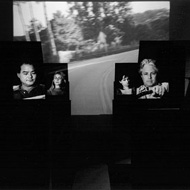
Sara Roberts, 2000
http://www.pair.xerox.com
http://www.banffcentre.ab.ca/bnmi/
http://www.media.mit.edu/
http://www.artcom.de
http://www.eyebeam.org/
http://www.hexagram.org
http://www.uiah.fi/~tleinone/history/art_technology.html
http://on1.zkm.de/zkm/e/
http://www.ntticc.or.jp/
http://www.iamas.ac.jp/concept/E/institute.html
http://web.mit.edu/cavs/people.html
http://www.coretext.net/2001a/clab-kluver.html
http://www.nyartsmagazine.com/62/eat.htm